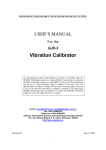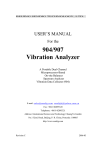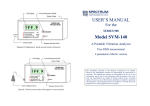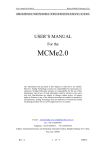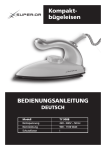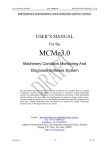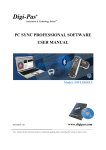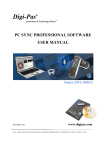Download the manual
Transcript
USER’S MANUAL For the 908 series Vibration Analyzer True RMS measurement 4 parameters Metric version The information provided in this Manual is believed to be reliable. However, the manufacturer assumes no responsibility for inaccuracies or omissions. The manufacturer assumes no responsibility for the use of this information, and all use of such information shall be entirely at the user's own risk. Specifications are subject to change without notice. No patent rights or licences to any of the functions described are implied or granted to any third party. The manufacturer does not authorise or warrant any of the products for use in life support devices or systems. Revision C 30-6-2005 1. Preparation in case of the outflow of the battery liquid; 4) If the sensor has been used for over one year, please re-calibrate the vibrometer to ensure the precision. 1). Check the voltage of the battery: Press <Measure> key, observe the display on the screen. If there is an arrow on the top left corner, you need to replace the battery with a new 4. Specifications one. 2). Set-up probe 1). Measurement condition: 908 standard has two probes while outside sensor has 1 probe and 1 Temperature:5-50oC, Humidity<85%, Non-causticity environment, Without magnetic mount. When changing, take hold of the screw cover to avoid strong electric-magnetic field & strong impact. It can be used in industry location by controlling the EMC environment throughout installation and/or usage. rotation and damage of the sensor. 2). Amplitude Ranges: Displacement 1−1999 µm peak-peak (*) 2. Measurement Velocity 0.1−199.9 mm/s true RMS 1). Select the measure parameters: Acceleration and High Frequency Acceleration: SENDIG-908 has 4 vibration parameters. They are: 0.1−199.9 m/s2 peak (*) a) Displacement (unit: µm = 1/1000 mm): Equivalent peak-peak value *Note: peak-peak and peak are equivalent value means: b) Velocity (unit: mm/s) : True RMS Value; peak-peak=2.828*RMS while peak=1.414*RMS c) Acceleration (unit: m/s2): Equivalent peak 3). Measurement accuracy: ± 5% of display ± 2 digits d) High Frequency Acceleration (unit: m/s2): Equivalent peak Noise Level (without input): ACC<0.25 m/s2, VEL<0.5mm/s, Disp<3µm 2). Functions of the <Measure> key: Frequency response accuracy: ±5%; ±10% for ACC 4.5kHz-10kHz a). Key press: Power on and begin measuring; Non-linearity: ±5% b). Key release: Hold the measured value for twenty seconds 4). Sensor type: Piezoelectric Accelerometer and then power off automatically. 5). Frequency response: 10−1000Hz (908B) 3). Stick the probe to the measured object (the pressure should be about 10−5000Hz (908) 0.5—1 kg.) High Frequency Acceleration: 1000-5000Hz ±10% 6). Battery: 9V 6F22, 25 hours of continuous operation. 3. Notes 7). Configuration: Standard: Inside accelerometer with 2 handheld probes 1). Avoid intense impact, high temperature and immersed in water. Optional: Outside accelerometer with magnetic mount and probe 2). Keep the sensor plug clean and dry, and use it carefully. 8). Dimensions: 13×6×2.3 cm; Weight: 200 g. 3). Install the battery: a) Open the small back cover of battery cabinet (2 screws at the end far 5. Warranty away from the sensor at backside, see figure); b) Place a battery (6F22, 9V) correctly according to the polarity; 3 years but not include those caused by mishandling. c) Close the back cover and screw the screws tightly; d) If it has been put aside long-term, please take out the battery


